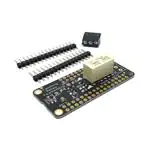Mini Relay FeatherWings
Created by lady ada
https://learn.adafruit.com/mini-relay-featherwings
Last updated on 2021-11-15 06:40:07 PM EST
©Adafruit Industries
Page 1 of 11
�Table of Contents
Overview
3
Pinouts
7
•
•
•
•
7
7
8
9
Plain (non-latching) Relay Control
Latching Relay Control
Relay Output
Reset Button
Downloads
9
•
•
•
•
9
10
10
11
Datasheets & Files
Non-Latching Schematic
Latching Schematic
Fabrication Print
©Adafruit Industries
Page 2 of 11
�Overview
A Feather board without ambition is a Feather board without FeatherWings! These are
the Mini Relay FeatherWing. They will give you power to control, and control over
power. Put simply, you can now turn on and off lamps, fans, solenoids, and other small
appliances that run on up to 250VAC or DC power using any Feather board.
Using our Feather Stacking Headers (http://adafru.it/2830) or Feather Female
Headers (http://adafru.it/2886) you can connect a FeatherWing on top of your Feather
board and let the board take flight. Check out our range of Feather boards here. (http
s://adafru.it/l7B)
©Adafruit Industries
Page 3 of 11
�The are two 'flavors' of these FeatherWings, the first is the simple Non-Latching relay.
This Wing has a single Set pin. Normally, the COM pin is connected mechanically to
the NC pin and the NO pin is disconnected.
When the SET pin is pulled high, the relay switches and the internal switch changes
so that the COM pin is mechanically connected to the NO pin and NC is then
disconnected
When the relay is active, a red LED is lit, and about 50mA of current is used to keep
the coil switched on. Note, if power is lost, the relay will go back 'open'
©Adafruit Industries
Page 4 of 11
�Now, you might be thinking "wow I really don't want to waste 50mA of current, that
will really sink my battery life!". OK good news, we have another type of FeatherWing,
the Latching FeatherWing. This one requires two pins, a SET and UNSET and instead
of keeping the SET pin high, you only have to pulse each pin high for 10ms to latch
the relay open or closed. You need two pins but save power. A red and green LED is
tied to each control transistor so you will see the LEDs blink when you set and unset
the relay
Note, if power is lost, the relay will stay in the last setting.
Both FeatherWings use the same family of relay. You can switch up to 2A of resistive
current at 30VDC or ~40VAC or lower. At 110VDC you can switch up to 0.6A, at
120VAC up to 0.5A, and at 250VAC you can switch up to 0.3A. Check the datasheet
for the relay for the exact switching capacity, and of course, for reactive/inductive
loads you will need to derate. This isn't a relay you can use to turn on and off your
washer/dryer, stick to 60W or less.
The coils for the relays are controlled through transistors with flyback diodes so you
do not have to worry about sourcing current from the control pin.
©Adafruit Industries
Page 5 of 11
�Each FeatherWing comes with a fully assembled and tested PCB, header you can use
to attach to your feather. You also get a 3-pin terminal block you can use to wire up
whatever you are going to be relay-controlling. Some light soldering is required
Please note: If using with high voltages (> 24V) use care and common sense! High
voltages require experience, and are only for use by engineers who are comfortable
with guidelines and know how to use safely!
©Adafruit Industries
Page 6 of 11
�Pinouts
Plain (non-latching) Relay Control
The plain relay uses a single pin for control. When the signal pin is floating or pulled
low, the relay is 'open' or unset. When the signal pin is pulled high, the relay switches
closed/set. A red LED next to the pin will let you know that the signal is high. You will
need to solder a wire from this pin to whatever control pin you like using a wire
Latching Relay Control
The latching relay uses two pins for control. There is no way to know which
'orientation' the relay is when the Feather turns on, because the relay will latch in the
last position it was set to.
When the SET pin is pulled high for 10 milliseconds, the relay switches closed/set. A
green LED next to the pin will let you know that the SET signal is high.
©Adafruit Industries
Page 7 of 11
�When the UNSET pin is pulled high for 10 milliseconds, the relay switches opens/
unset. A red LED next to the pin will let you know that the UNSET signal is high.
You will need to solder wires from the SET & UNSET pads to whatever control pins
you like using wires
Relay Output
Both Wings have the same output, a 3-pin 3.5mm terminal block. The COM pin is what
you should connect the signal you're planning to switch. If the relay is unset, the NC
pin (Normally Connected) is mechanically connected to COM. NO (Normally Open) is
mechanically disconnected.
When the relay is set, NC becomes disconnected from COM and NO is connected to
COM
©Adafruit Industries
Page 8 of 11
�Reset Button
There is a Reset button on both Wings, this is connected to the RST pin and will short
it to ground. It is not connected to the relay at all, its handy for restarting your Feather
Downloads
Datasheets & Files
• EagleCAD Files on GitHub (https://adafru.it/omD)
• Datasheet for the relays used (https://adafru.it/msd)
• Fritzing object available in the Adafruit Fritzing Library (https://adafru.it/aP3)
©Adafruit Industries
Page 9 of 11
�Non-Latching Schematic
Latching Schematic
©Adafruit Industries
Page 10 of 11
�Fabrication Print
©Adafruit Industries
Page 11 of 11
�
很抱歉,暂时无法提供与“2923”相匹配的价格&库存,您可以联系我们找货
免费人工找货